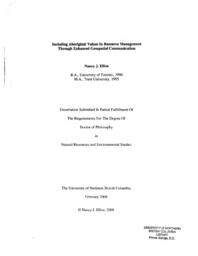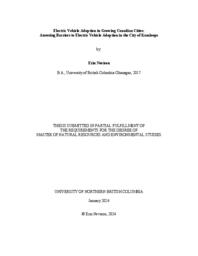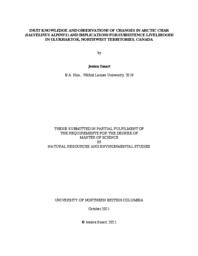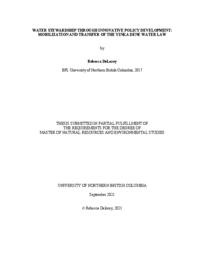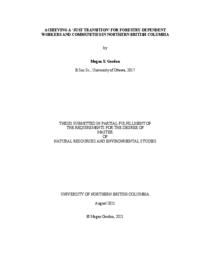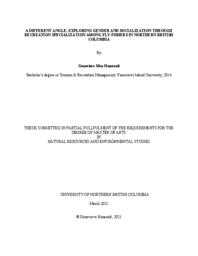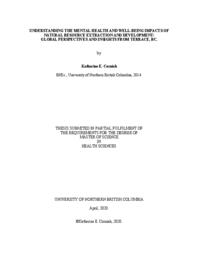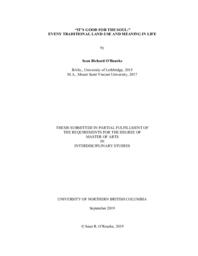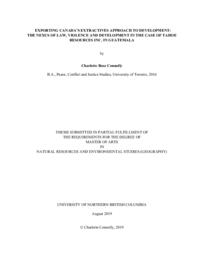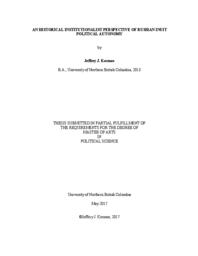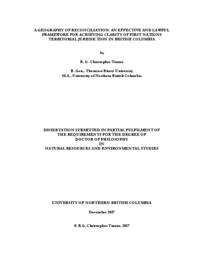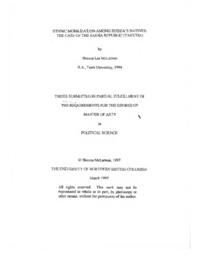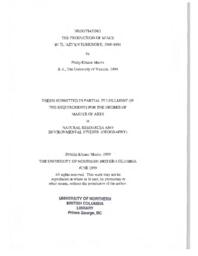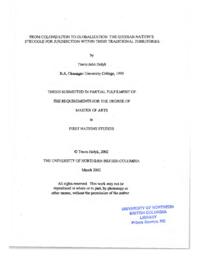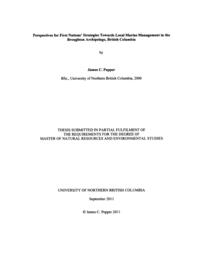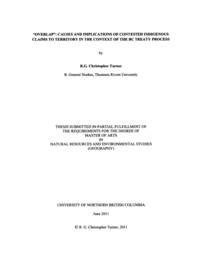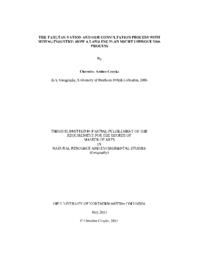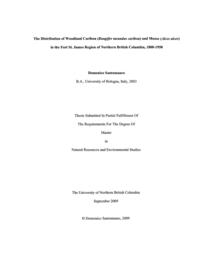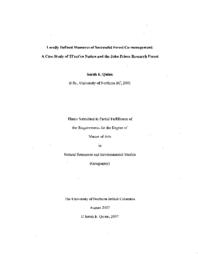Fondahl, Gail
Person Preferred Name
Gail Fondahl
Related Works
Content type
Digital Document
Origin Information
Content type
Digital Document
Description / Synopsis
Greenhouse gas emissions from transportation are a significant contributor to climate change. An effective method of reducing these transportation emissions is to electrify transportation. Local governments are creating electric vehicle policies to increase electric vehicle adoption in their communities. The City of Kamloops released their EV Strategy to encourage local electric vehicle uptake in 2020 but encountered barriers to local electric vehicle adoption such as a lack of charging infrastructure, a hesitancy to new technology, and the high prices of EVs. There is no significant research on EV adoption and barriers within a smaller city, regional hub, or Canadian context. To address this, I conducted a content analysis, literature review, and key informant interviews with six stakeholder groups in Kamloops to assess the perceived barriers to EV adoption. My research compares the perceived barriers within the context of Kamloops and provides policy solutions to the City of Kamloops to overcome these barriers and reduce transportation emissions. The City should continue to prioritize EV adoption through public education campaigns, encourage the building of charging stations, and focus on densification for an overall reduction of emissions and to provide convenient places for EV drivers to charge their vehicles.
Origin Information
Content type
Digital Document
Description / Synopsis
This thesis documents and examines recent changes observed in anadromous Arctic char (Iqalukpik) (Salvelinus alpinus) in Ulukhaktok, Northwest Territories, Canada, including how these changes are being experienced and responded to by community members. Ulukhaktomiut identified a need to document their knowledge and observations of Arctic char to help inform comanagement. The analysis of 20 semi-structured interviews with Ulukhaktomiut revealed six main concerns about Arctic char linked to changes arising in the local environment: (1) presence of salmon, (2) increasing temperature, (3) inconsistent sea and lake ice conditions, (4) changing weather patterns, (5) fluctuating water levels, and (6) the recent presence of tunicates in the ocean. Ulukhaktomiut respond to these changes at the individual and community levels, including altering fishing practices and temporarily halting commercial fishing. The results show that Ulukhaktomiut are astute observers of their local environment and are able to share highly detailed knowledge and observations of Arctic char. Environmental changes are emerging quickly, and there is a great deal of uncertainty among Ulukhaktomiut about why these changes are occurring and what impact they may have on Arctic char. Fisheries management structures will need to be flexible and responsive to ongoing local observations and the best available science to sustain a viable Arctic char fishery now and into the future.
Origin Information
Content type
Digital Document
Description / Synopsis
Policy mobility and transfer play a role in larger policy development and implementation processes, as actors look elsewhere for policy solutions to local issues. Conducted in collaboration with the Nadleh Whut’en First Nation and guided by an Indigenous methodology based on the Too Declaration with support from constructivist grounded theory, this research explores the mobilization and transfer of the Yinka Dene Water Law. Conversations with participants representing First Nations and interest groups reveal that the Water Law is being mobilized by individuals and groups at a variety of scales, and use varies from adoption and implementation, to inquiring about its transfer. This research also discusses factors influencing Water Law transfer, including shared policy problems and its function as a communication tool. There are few empirical examples of policy transfer processes between Indigenous contexts. This research contributes to filling this gap in the policy transfer literature by exploring such transfer between First Nations, and advances Nadleh Whut’en’s stewardship and implementation related objectives.
Origin Information
Content type
Digital Document
Description / Synopsis
‘Just transition’ is a burgeoning policy goal, as well as an academic and social justice concept. Governments are increasingly operationalizing just transition policy approaches as they realize the scale and scope of industrial transition needed to meet climate targets, recognizing the impact this transition will have on workers and communities. However, there is little consensus on what is considered ‘just’ and ‘fair’. Through interviews with over 40 participants in the Cariboo Regional District (during the COVID-19 pandemic), this thesis will provide insights into the concept of a just transition according to forestry-dependent workers and communities. This research examines the Government of British Columbia’s ‘Supports for Interior Forestry Workers’ programs in response to the 2019 forest sector downturn and describes lessons about how impacted workers and community members evaluate transition management based on their perceptions and values. This work also offers principles and practices for delivering just transition policy and program supports. This research suggests that the Government of British Columbia must adjust existing supports and proactively develop policy measures to manage and mitigate the negative consequences of future transitions in collaboration with other key actors.
Origin Information
Content type
Digital Document
Description / Synopsis
Studies of how gender is characterized, performed, and understood in outdoor activities in relation to skill development are limited, but growing. This research explored gender and social relationships across levels of recreation specialization in fly-fishing among anglers in Prince George, BC. Semi-structured interviews were conducted with 23 participants, 11 of whom then attended a level-specific fishing day during which participant observation was conducted. Interviews were transcribed and coded. Four main findings were derived. First, anglers’ social relationships shifted from dependence on others to intentional self-expression. Second, anglers learned to belong ecologically and socially through skill development and equipment use. Third, anglers’ relationships with fish moved from possession to communion. Fourth, anglers’ described escaping their daily routines to engage with rural places and fishing. The analysis and discussion show how masculinity was constructed and performed, and highlight the roles of socialization, behaviors, and equipment in shaping and gendering rural settings.
Origin Information
Content type
Digital Document
Description / Synopsis
This research couples a global scale targeted systematic review with the perspectives and experiences of mental health service providers in Terrace, British Columbia. A targeted systematic review was conducted exploring mental health and well-being impacts of resource extraction globally. Findings informed qualitative interviews with mental health service providers in Terrace, BC. Main themes from service providers are systemic issues in health care, poor access to mental health services for children and youth, mental health risk factors, social determinants of health, and industry’s lasting influence and legacy. Synthesis of the findings from the systematic review and interviews with service providers indicates providers concerns aligned with the global literature. A synthesis combines the two phases of research. Insights from this work suggest a greater consideration of the social and mental health impacts of industrial projects is necessary, and there is need for equitable access to mental health resources for all ages.
Origin Information
Content type
Digital Document
Description / Synopsis
Federal laws in the Russian Federation set out restrictive criteria for Indigenous peoples to be recognized politically, socially, and culturally as Indigenous Small Numbered Peoples of the north (KMNS). These criteria emphasize “traditionality,” a strategic tactic equating indigeneity with rural landscapes and thus discounting urban Indigenous individuals and communities as modern political and self-determining subjects. Stories from Indigenous women living in Yakutsk, the capital city of Sakha Republic (Yakutia) challenge these narratives by reconstituting the urban landscape from an Indigenous perspective. The challenges emanating from urban landscapes, and relationships integral to navigating these challenges, are examined in this thesis from a critical Indigenous feminist geographical framework, honouring and celebrating the numerous manifestations of urban indigeneity entangled throughout Yakutsk.
Origin Information
Content type
Digital Document
Description / Synopsis
Following Russian/Soviet colonization, Indigenous Siberian Eveny less frequently engage in hunting and reindeer herding—land-based activities central to their culture. Research suggests that an inability to engage in key cultural activities may hamper Indigenous peoples’ capacities to construct meaningful existences (i.e., fulfilling lives with purpose), but this has not been empirically investigated among Eveny. I conducted 14 semi-structured interviews on traditional land-use and meaning in life with Eveny men in Batagay-Alyta (Sakkyryr), Sakha Republic (Yakutia), Russia. Half of the participants lived in the village; the other half were nomadic herders. Both herders and non-herders described meaningful existences, but the groups often acquired meaning from different sources. Some sources (i.e., family, finances, reindeer) were deemed important by both groups. My findings illuminate what makes life meaningful for some Eveny, and can help policy-makers better address their unique needs.
Origin Information
Content type
Digital Document
Description / Synopsis
In Russia’s largest region, the Sakha Republic (Yakutia), Indigenous (KMNS) leaders and communities representing five different cultural groups have succeeded in preserving traditional ways of life, and particularly nomadic reindeer husbandry, through the enormous political, social, and environmental changes of the past century. To ensure continued cultural survival, Indigenous leaders have developed a wide range of political and legal instruments, processes, and bodies within and without Russian governance structures. Key among these instruments is the “Territory of Traditional Nature-Use” (TTP), a geographically bounded legal-cultural landscape within which dozens of normative republican and federal acts, constitutional laws, and codices regulate and protect traditional land-use, socioeconomic organization, and ways of life.
Origin Information
Content type
Digital Document
Description / Synopsis
Drawing on theories of critical legal geography and critical development studies, this thesis examines how law shapes processes of repression and resistance in conflicts over resource extraction. Through the lens of Canadian mining in Guatemala and the specific case of Tahoe Resources’ El Escobal Mine, I reflect on how law impacts the production, control, and remaking of space and place. A discourse analysis of documents obtained via Access to Information and Privacy (ATIP) requests, as well as an analysis of fieldwork notes and semistructured interviews conducted in Guatemala and Canada between May and September 2018, demonstrate that a lack of government oversight and accountability reinforces a status quo of impunity for human rights abuses related to Canada’s extractive sector. While home state litigation may enforce a measure of accountability for parent companies in their operations abroad, the ideological structures enabling mining corporations to operate with ease across borders remain intact.
Origin Information
Content type
Digital Document
Origin Information
Content type
Digital Document
Origin Information
Content type
Digital Document
Origin Information
Content type
Digital Document
Origin Information
Content type
Digital Document
Origin Information
Content type
Digital Document
Origin Information
Content type
Digital Document
Origin Information
Content type
Digital Document
Origin Information
Content type
Digital Document
Origin Information
Content type
Digital Document
Origin Information
Content type
Digital Document
Origin Information
Content type
Digital Document
Origin Information
Content type
Digital Document
Origin Information
Content type
Digital Document
Origin Information

